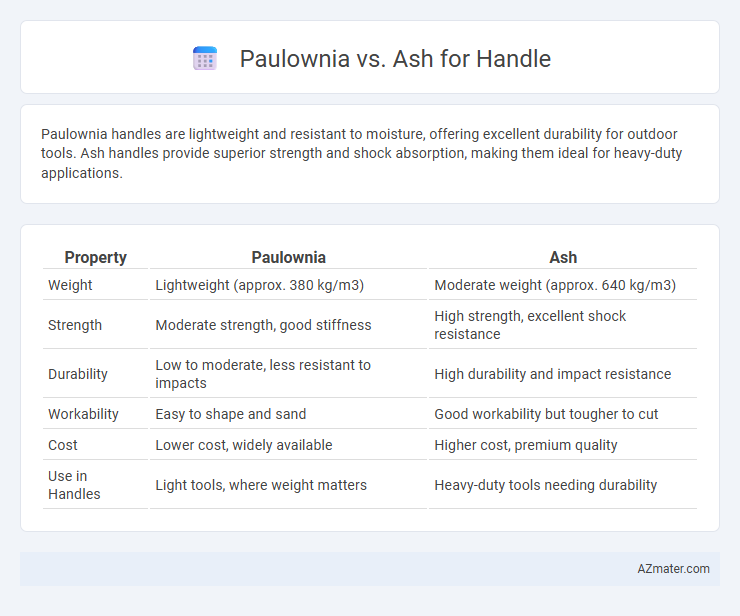Paulownia handles are lightweight and resistant to moisture, offering excellent durability for outdoor tools. Ash handles provide superior strength and shock absorption, making them ideal for heavy-duty applications.
Table of Comparison
| Property | Paulownia | Ash |
|---|---|---|
| Weight | Lightweight (approx. 380 kg/m3) | Moderate weight (approx. 640 kg/m3) |
| Strength | Moderate strength, good stiffness | High strength, excellent shock resistance |
| Durability | Low to moderate, less resistant to impacts | High durability and impact resistance |
| Workability | Easy to shape and sand | Good workability but tougher to cut |
| Cost | Lower cost, widely available | Higher cost, premium quality |
| Use in Handles | Light tools, where weight matters | Heavy-duty tools needing durability |
Introduction to Paulownia and Ash Wood
Paulownia wood is lightweight, known for its rapid growth and resistance to warping, making it an ideal choice for handles requiring durability without added weight. Ash wood offers exceptional strength and shock absorption, favored in tool handles for its toughness and flexibility under stress. Both woods provide distinct advantages depending on the balance needed between weight and sturdiness in handle applications.
Physical Properties Comparison
Paulownia wood is significantly lighter, with a density of around 0.28 g/cm3 compared to Ash, which has a density of approximately 0.68 g/cm3, making Paulownia ideal for lightweight tool handles. Ash exhibits superior strength and shock resistance due to its higher modulus of rupture and elasticity, providing durability under heavy use. Moisture content absorption is lower in Paulownia, resulting in better dimensional stability and less warping compared to Ash in varying environmental conditions.
Strength and Durability Differences
Paulownia wood offers a lightweight handle option with moderate strength, making it ideal for tools requiring easy maneuverability but less impact resistance. Ash, renowned for its superior toughness and shock absorption, provides durable handles that withstand heavy use and bending forces without cracking. The denser fiber structure of ash results in higher strength and longevity compared to the softer, more flexible paulownia.
Weight and Handling Comfort
Paulownia wood offers exceptional lightweight properties, making it a top choice for handle construction where reduced weight enhances handling speed and agility. Ash, while heavier than Paulownia, provides superior shock absorption and a comfortable grip, reducing hand fatigue during prolonged use. The balance between Paulownia's lightness and Ash's ergonomic comfort determines optimal handle performance based on specific user needs.
Moisture Resistance and Stability
Paulownia exhibits superior moisture resistance compared to ash, making it less prone to warping and swelling in humid environments. Ash offers excellent stability and strength, but its higher moisture absorption can lead to dimensional changes over time. For tool handles requiring consistent performance in wet or variable conditions, paulownia provides enhanced durability due to its low water content and natural resistance to decay.
Workability and Machining
Paulownia offers exceptional workability with its lightweight and fine-grained structure, making it easier to shape and sand for handles, but it may lack the durability needed for heavy-duty use. Ash, known for its strength and shock resistance, machines well despite being denser, providing a solid and durable handle ideal for tools requiring impact resilience. Both woods respond well to common woodworking tools, but ash's toughness demands sharper blades and more effort during machining compared to the softer and more forgiving paulownia.
Cost and Availability
Paulownia wood offers a lightweight and cost-effective option for handles, typically priced lower than ash due to its rapid growth and widespread availability in Asia. Ash is readily available in North America and Europe, known for its durability and shock resistance, but generally comes at a higher cost compared to paulownia. While paulownia handles provide affordability and ease of use, ash is preferred for heavy-duty tools where strength and longevity justify the additional expense.
Aesthetic Qualities
Paulownia wood features a light, pale color with subtle grain patterns that offer a clean, minimalist aesthetic ideal for modern tool handles. Ash boasts a more prominent grain with contrasting light and dark streaks, providing a classic, rustic appearance favored in traditional handle designs. The choice between Paulownia and Ash depends on desired visual impact and design context, with Paulownia delivering sleek elegance and Ash emphasizing natural boldness.
Environmental Impact and Sustainability
Paulownia offers a significantly lower environmental impact compared to Ash due to its rapid growth rate and ability to thrive with minimal water and nutrient inputs, making it a highly sustainable wood option for handles. Ash trees grow slower and require more resources, which contributes to greater habitat disruption and carbon emissions over time. Choosing Paulownia handles supports forest conservation efforts and reduces the ecological footprint associated with wood harvesting.
Best Applications for Each Wood Type
Paulownia excels in lightweight applications such as tool handles for gardening and sports equipment, where ease of use and reduced fatigue are critical. Ash offers superior strength and shock resistance, making it ideal for heavy-duty handles like baseball bats, axes, and hammers that demand durability and impact absorption. Choosing between Paulownia and Ash depends on prioritizing weight versus strength according to the specific requirements of the handle's use.

Infographic: Paulownia vs Ash for Handle
 azmater.com
azmater.com